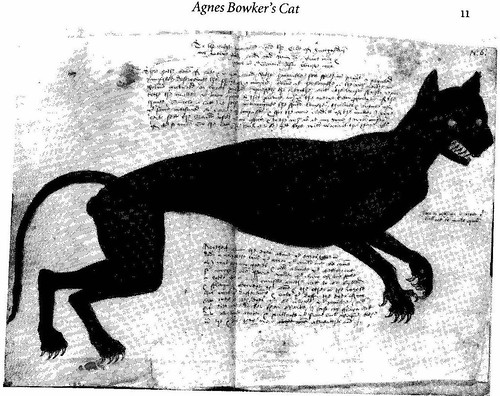.flickr-photo { border: solid 2px #000000; }.flickr-yourcomment { }.flickr-frame { text-align: left; padding: 3px; }.flickr-caption { font-size: 0.8em; margin-top: 0px; }
Yes, Friday cat blogging, but not as you know it. Be warned!
It was 1568. Agnes Bowker, 27, daughter of the late Henry Bowker of Harborough, Leicestershire,, a spinster and domestic servant in the same town, found herself with a difficult, but hardly unusual problem – she was pregnant.
Cast out by her employer when her predicament became evident, she seems to have wandered the countryside until on the 16th of January the following year she gave birth, after an apparent gestational period of 53 weeks, with in attendance a midwife and several “gossips” (female matrons).
This, however, is where the story gets very strange indeed. For she gave birth, it seemed, to a “monster”, as she called it, or what was clearly a cat, as forensic examiners saw it.
Based on her later testimony, the father might have been another servant, Randal Dowley, who suspiciously fled the area and was never heard from again, it might have been an apparently shape-shifting beast that assumed the form of a cat, a bear or a man, or a sinister schoolmaster, Hugh Brady.
It seems pretty clear, to me anyway, that she was covering up either a late abortion or infanticide. Panic-stricken, she doesn’t seem to have thought that this was not a way of quietly covering up what she had done.
That, tragically, in 2005, some girls or women should still find themselves in the same situation is evidenced by the recent discovery of a baby’s body on Teeside. I heard on a radio that a girl, 15, had come forward.
But anyway, back to the history – Agnes’s tactic eventually worked, in that she escaped punishment – which could have been the rope for infanticide – and disappeared back into history.
One of the remarkable things about this case, and there are many, is the way the local official charged with investigating the case, Anthony Anderson, went about his work.
His is the drawing of the “monster” above, done with meticulous forensic care. “This picture … containeth the full length, thickness and bigness of the same, measured by a pair of compasses.”
The townsfolk had already dissected it, and found a piece of bacon in its throat that obvious convinced most of the men that this was just a piece of trickery.
Now the official charged that another cat be killed and flayed, so that its shape could be compared to the “baby”. He found the only difference was in the colour of the eyes. “I cast my flayn cat into boiling water, and pulling the same out again, both in eye and else they were altogether one.” (p. 21)
Surprising is the matter of fact “scientific” way he attempted to establish the facts. Was this the perhaps surprisingly early spread of the scientific method out into the countryside, or simply an application of rural commonsense?
Less unexpected was the political use that the appearance of this “apparition” was put; with Elizabeth only uncertainly on the throne, and religious uncertainty still rife, Such births showed something was wrong in the nation, and God was sending a sign to say: “Fix it.”
This is the title story in the book by David Cressy from which I posted that nice collection of curses yesterday.
Sharon asked me a couple of weeks ago what I think of it. Well it has some wonderful stories and period detail, as this story suggests, but I do find it curiously lacking in theory or even a coherent approach.
There’s a nod to “postmodernism” at the start, but it seems to take this to mean just presenting competing narratives without attempting to draw any distinctions between them, a rather simplistic idea of the approach.
Associated is an expressed desire not to draw conclusions, although as the book progresses it is increasingly dotted with them, often it seem to me on very flimsy grounds.
On factual topics on which I have some knowledge I also have some doubts. e.g. on p. 66-67 “A variety of medicines was used ‘to bring down or provoke a woman’ flowers’, to stimulate menstruation, or ‘to hasten the bringing forth’ of a child from the womb and this knowledge was widely distributed through printed herbals and through women’s lore.”
The reference given for this is John M Riddle, Contraception and Abortion from the Ancient World to the Renaissance; and possibly David Cressy, Birth, Marriage and Death: Ritual, Religion and the Life Cycle in Tudor and Stuart England 47-50).
But this seems to contradict everything I’ve read on this issue, which says while the midwife’s oath included a promise not to use such substances – suggesting they were known to exist – such dangerous, illegal knowledge was never written down.
Can anyone comment on that?
LATE ADDITION: I notice that “Ephelia” has just posted on another similar case, that of Mary Toft, who claimed to have given birth to rabbits (having apparently experienced a series of miscarriages).


 About
About
4 Comments